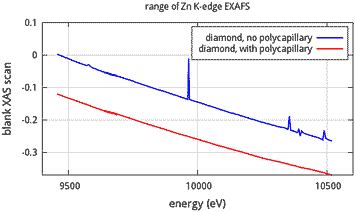A Single Diamond Crystal Does the Job
August 22, 2014
X-ray absorption spectroscopy (XAS) is a technique used in many areas of science, from biology to materials science,that allows researchers to uncover information on a sample's molecular structure and electronic behavior by studying how it absorbs and re-emits x-rays. Recently, a research team working at the National Synchrotron Light Source developed a way to improve certain XAS experiments by replacing a standard experimental component, an x-ray beam monitor, with a diamond-based type that is better performing but has been incompatible with many XAS experiments due to technical roadblocks.

X-ray absorption spectroscopy (XAS) scans over energy ranges typical of XAS experiments
The most common type of beam monitor is an ionization chamber, which consists of a gas-filled chamber between two charged electrodes. When x-rays pass through the gas, they ionize the molecules and cause a tiny but measurable current to flow between the electrodes. By calculating backward from the amount of current, researchers can determine the “flux” of the x-ray beam; that is, the total number of x-ray photons passing through a unit area as a function of the beam energy.
Diamond sensors, which consist of a single diamond crystal, have many advantages over ionization chambers, including faster response times, less leakage current, and smaller size. But even as electronics-grade diamond is more readily available, they have not been commonly used in XAS because they respond poorly during experiments that require scanning over a large energy range. Often the range of the scan includes the Bragg diffraction energies for diamond – x-rays with wavelengths that are diffracted by the diamond rather than transmitted through it. (If the range of the energy scan avoids this value, then diamond sensors can simply be swapped out for ionization chambers.)
“Measuring XAS data with a diamond sensor through an energy region that produces diffraction peaks yields data that require extensive post-processing,” said the study's corresponding scientist, Bruce Ravel of the National Institute of Standards and Technology. “We have found a way that diamond sensors can be used, at least for certain XAS experiments, without having to do so much work to the data.”
Ravel and his colleagues, from Stony Brook University, Brookhaven National Laboratory, and Case Western Reserve University, discovered that coupling the diamond sensor to an optic component known as a “half polycapillary lens” significantly mitigates the diffraction problem. The lens consists of a bundle of tiny glass tubes encased in a steel cylinder, with one end of the tubes drawn into a taper (in a full lens, both ends are tapered). The lens “smears” the x-ray beam before it reaches the diamond sensor, causing the diffraction effect to be far less pronounced.
“The data we gathered using both the diamond sensor and the lens are of comparable quality as data taken using an ionization chamber and no lens,” said Ravel.
The results of their investigation have led the group to propose combination devices, with a diamond window placed onto the end of the steel cylinder that encases the glass tubes, instead of the usual beryllium window.
X-ray data for this study were collected at NSLS beamline X23A2. The paper describing the work is published in the October 2013 issue of Review of Scientific Instruments.
2014-5140 | INT/EXT | Newsroom









